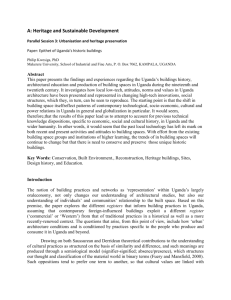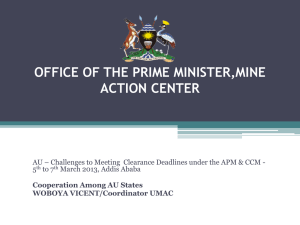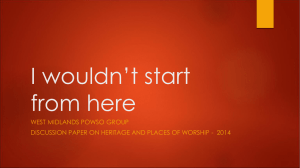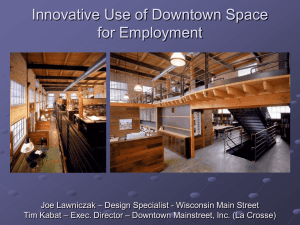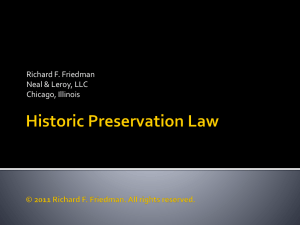The Issue of Historic Buildings
advertisement
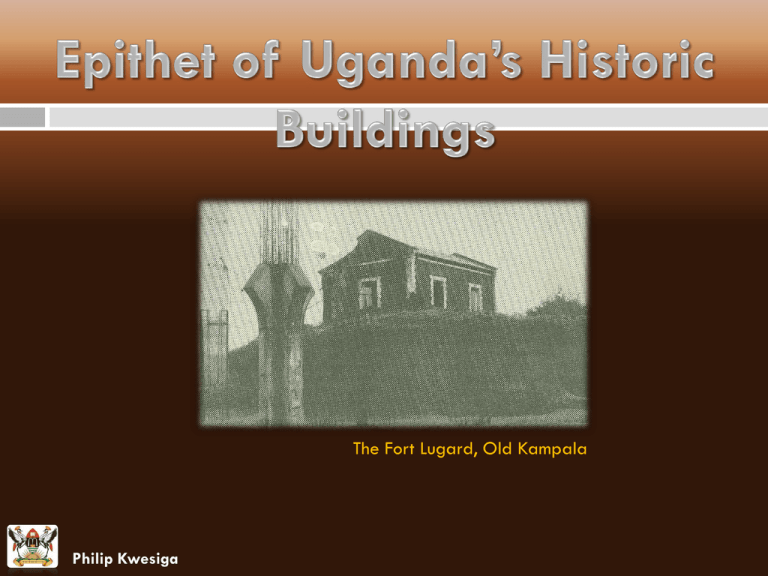
The Fort Lugard, Old Kampala Philip Kwesiga This paper presents findings and experiences regarding the Uganda’s buildings history, architectural education and production of building spaces in Uganda during the nineteenth and twentieth century Epithet of Uganda’s Historic Buildings Our Historic Treasures Wamala Tombs Shifts in Building Space The shift in building space itself reflect patterns of contemporary technological, socio-economic, cultural and power relations in Uganda in general and globalization in particular The socioeconomic contact It is an attempt to account for previous technical knowledge dispositions, specific to economic, social and cultural history, in Uganda and the wider humanity. Our Historic Building It is argued that the past local technology has left its mark on both recent and present activities and attitudes to building spaces Institutional Influences the existing building space groups and institutions of higher learning, the trends of in building spaces will continue to change but that there is need to conserve those unique historic buildings The old in conflict with the new Conservation, Built Environment., Reconstruction, Heritage buildings, Sites, Design history, and Education. Building practices and networks as ‘representation’ within Uganda’s largely oral economy Buildings mirror the individuals’ and communities’ relationship to the built space That ‘urban’ architecture conditions and is conditioned by practices specific to the people who produce and consume it Hinges on both Saussurean and Derridean theoretical contributions to the understanding of cultural practices as structured on the basis of similarity and difference Starts in 2006, when Prof Merrick Posnansky made an emotional plea for the Commission of Historical Monuments to be revived The challenge of conservation should not be the work of one person or even a commission; rather it should be the work of every Ugandan population and community The self in Uganda has continued to lead as the goal for living But Ugandans forget that the self is made of a history and a culture which has to be observed and conserved Public spaces are now largely in private hands as opposed to traditional national institutions These significant buildings are at risk because their owners or managers are unaware of their importance. We should not be afraid to mention the state of our historic buildings for the gazetted sites and monuments are in shambles It shares with related concepts such as integrity and honesty, a family resemblance (Ruskin termed ‘the pathetic fallacy’) This in Uganda raises the question whether a building can really be ‘compromised,’ its ‘integrity’ questioned, its ‘character’ altered especially in Africa communities? Uganda in particular is probably the best known of all earth walled building types. Their thick walls are made by piling a mixture of subsoil and straw Historic buildings in Uganda may achieve the best attention when they are in full protection of an institution or community that owns it Such historic buildings belonged to the traditional monarchies that have never fully recovered from woos of majestic governance which eventually transformed into democratic and capitalistic states. They is decay and neglect of some of the important historic buildings. Some organizations made up of a cross section of conservationists from within and outside Uganda, started the Historic Building Conservation Trust (HBCT) and the Cross-Cultural Foundation of Uganda (CCFU) New thinking and planning of community settlement has taken root, mostly in central Uganda (Buganda). Uganda has thriving city and towns with historic buildings standing alongside sleek modern built areas The planning has not been systematic for this buildings of all styles are show cased as a manifestation of Uganda’s unique history Traditional architecture has gradually improved as communities began to rub shoulders with cosmopolitan living spaces The levels of preservation and conservation also leave a lot to be desired. The identification of national historic buildings by the HBCT and CCFU has been adhoc criteria should be considered. These should include the quality of significance in Uganda’s history, architecture, archaeology, engineering and culture Some of the buildings include: Nakasero Fort, Fort Lugard, Twekobe Palace, The Art School, The Main Building – Makerere University, Ham Mukasa House, Namirembe Cathedral, The High Court, Sir Apolo Kaggwa House and Church, The National Laboratory Building, The Clock Tower, Art Décor Corner House and Nakasere Market A number of gazetted buildings in Jinja and Entebbe townships. There is need to streamline building permits which are handled by the city and town councils New buildings should go through a rigorous review before plans are approved and where there also listed buildings, plans should be put in place to preserve the features of such buildings Developers should comply with the provisions of that city or town Historic Conservation and Preservation guidelines in planning and executing the projects Routine maintenance and repair of existing historic building fabric, including painting, small scale alterations of buildings that do not change the overall appearance and integrity of the structure should be encouraged
